Even though Earthling scientists are studying Mars intently, it’s still a mysterious place.
One of the striking things about Mars is all of the evidence, clearly visible on its surface, that it harbored liquid water. Now, all that water is gone, and in fact, liquid water couldn’t survive on the surface of the Red Planet. Not as the planet is now, anyway.
But it could harbour water in the past. What happened?
Mars has only a thin atmosphere now, and that atmosphere isn’t thick enough to maintain water now. So it must have had a thicker, warmer atmosphere in the past. And that atmosphere could only have persisted if Mars also had a protective magnetosphere.
Astronomers are pretty certain that Mars lost its magnetosphere about 4 billion of years ago. And without a protective magnetosphere like Earth has, the stellar wind from the Sun had free access to Mars, and simply stripped its atmosphere away, lost to space forever.
And once that happened, Mars was doomed. The water and atmosphere disappeared, and Mars got cold and dry.
Earth’s magnetosphere is created by a dynamo at the planet’s core; a rotating and convective clump of molten iron and nickel. Mars must have had one, too. It’s the only way it could’ve generated a protective magnetosphere to shield it from the Sun. But Mars is smaller than Earth, and following its formation, the planet cooled more quickly than Earth did. Once it cooled, it lost its core iron/nickel dynamo, then its atmosphere, then its water. Poor Mars.
But Mars does still have a magnetic field, albeit a weak one, and NASA’s MAVEN (Mars Atmosphere and Volatile Evolution) spacecraft has mapped it. Rather than a global dynamo magnetic field like Earth’s, Mars now has an induced magnetosphere.
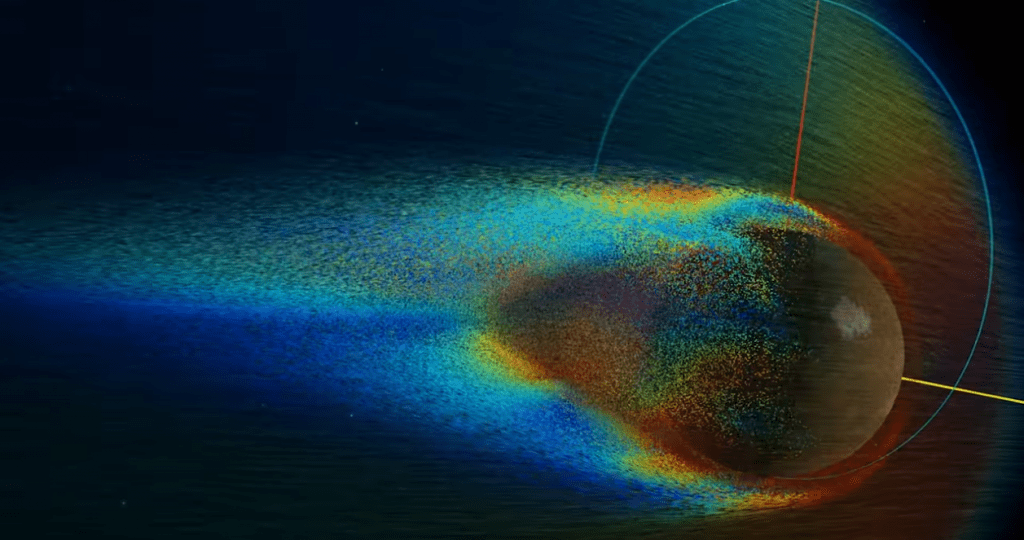
MAVEN arrived at Mars and went into orbit around the planet in September 2014. Five years of data from the mission have led to a new map of Mars’ weak magnetic field. Researchers are using this map to help understand Mars’ history, and how it lost its atmosphere.
A new paper presents these findings in the journal Nature Astronomy. The paper is titled “The global current systems of the Martian induced magnetosphere.” The lead author is Robin Ramstad of the University of Colorado, Boulder.
“These currents play a fundamental role in the atmospheric loss that transformed Mars from a world that could have supported life into an inhospitable desert,” said lead author Ramstad in a press release. “We are now currently working on using the currents to determine the precise amount of energy that is drawn from the solar wind and powers atmospheric escape.”
Mars induced magnetic has a different cause than one created by a dynamo at a planet’s center. It’s caused by electromagnetic interaction between the solar wind, which is a magnetized flowing plasma, and the non-magnetized planet itself. The currents produced by that interaction give clues “into the solar wind’s role in powering the heating, escape and evolution of planetary atmospheres,” according to the authors of the paper.
Earth’s magnetic field is pretty well understood, and has been studied for decades. But induced fields like Mars’ are not. This five-year study by MAVEN is the most in-depth study yet.
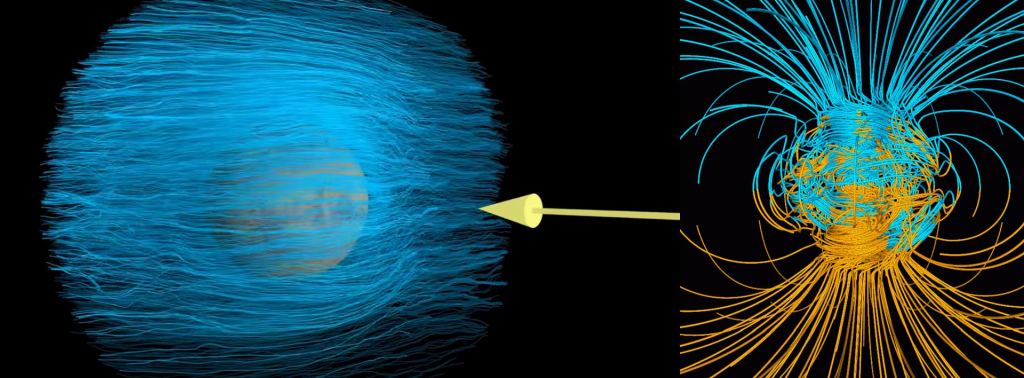
The solar wind is a stream of charged particles that slams into everything around the Sun at almost a million miles per hour, or 1.6 million kilometers per hour. It interacts with everything in the Solar System. The wind itself is magnetized, so it actually has difficulty penetrating the upper atmosphere of non-magnetized Mars. Instead, it creates currents in the ionosphere. That actually strengthens the magnetic field, producing the induced magnetosphere. It’s only now, thanks to this study, that scientists are understanding how this all works.
When the ions and electrons in the solar wind collide with this induced magnetic field, some of the ions are directed to flow one way, and some of the electrons are directed the opposite way. That forms electric currents, and they travel around the planet, from dayside to nightside.
At the same time, x-ray and ultraviolet radiation from the Sun strikes Mars’ upper atmosphere, ionizing some of it constantly. That turns some of the upper atmosphere into electrons and electrically charged ions that conduct electricity.
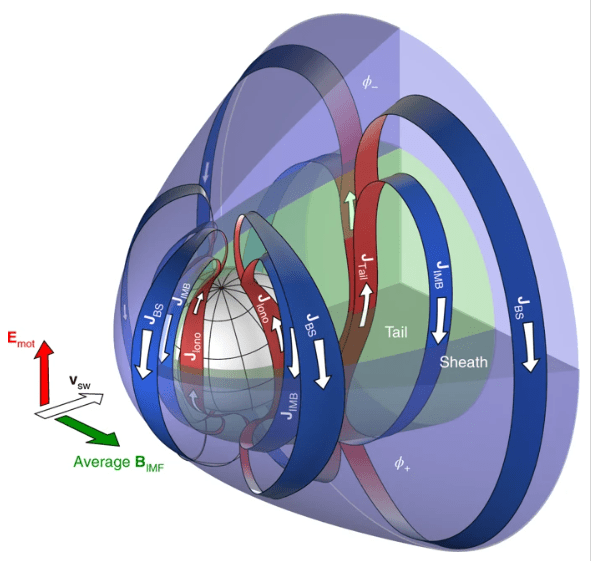
Lead author Ramstad describes it like this: “Mars’ atmosphere behaves a bit like a metal sphere closing an electric circuit. The currents flow in the upper atmosphere, with the strongest current layers persisting at 120-200 kilometers (about 75-125 miles) above the planet’s surface.”
MAVEN, and other missions, have seen localized hints of these current layers before. But i’ts only now, after five years, that scientists have been able to map the complete circuit, from its generation in the solar wind, to where the electrical energy is deposited in the upper atmosphere.
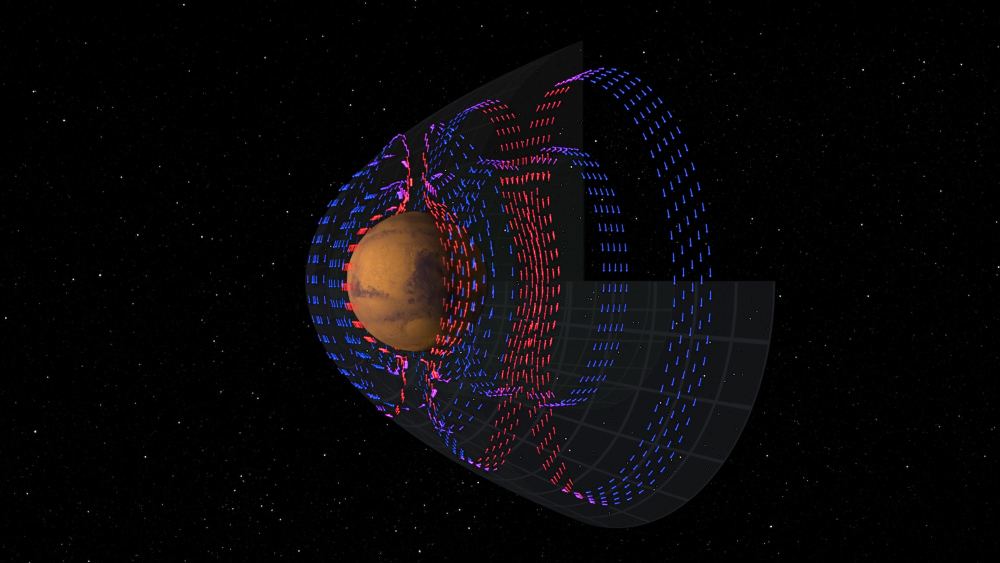
It’s extraordinarily difficult to “see” these electrical currents in space. But one of MAVEN’s instruments is a sensitive magnetometer. Though it can’t see the electrical currents, it’s created a 3D map of magnetic field lines around Mars. Scientists were then able to map the currents onto the distortions in the field lines.
“With a single elegant operation, the strength and paths of the currents pop out of this map of the magnetic field,” Ramstad said.
The result is a more detailed understanding of exactly how the Sun stripped Mars of its atmosphere. Once the global dynamo magnetic field was gone, the solar wind formed a direct connection to Mars’ upper atmosphere, creating electrical currents. Those currents then drove charged particles in the atmosphere out into space.
The authors of the paper say that other planets without magnetospheres likely have the same induced fields, at least at a top level.
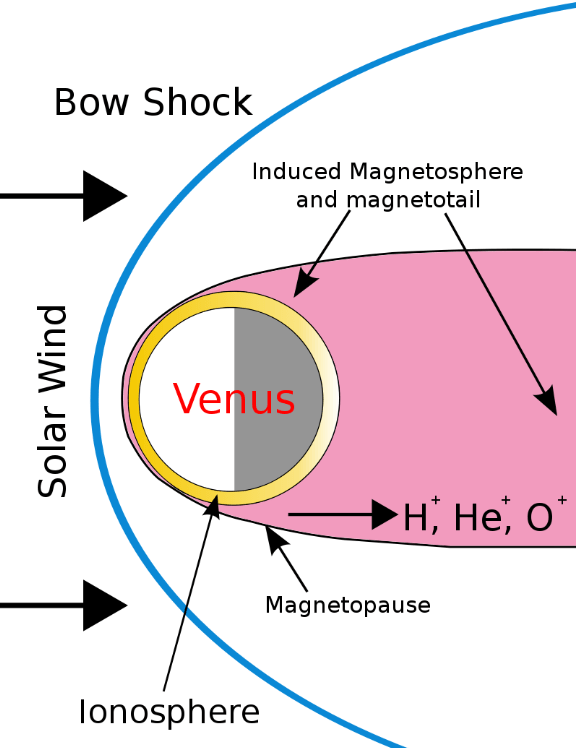
“The current systems of the Martian induced magnetosphere are predominantly driven by a magnetospheric convective electric field,” the authors write. “These results represent the typical configuration at Mars and, to first order, probably also represent convection-driven induced magnetospheres in general. This configuration, however, is not the only possible configuration for induced magnetospheres.”
This process of atmospheric loss began sometime around 4 billion years ago, when Mars lost its magnetic field. And it’s still happening today.
